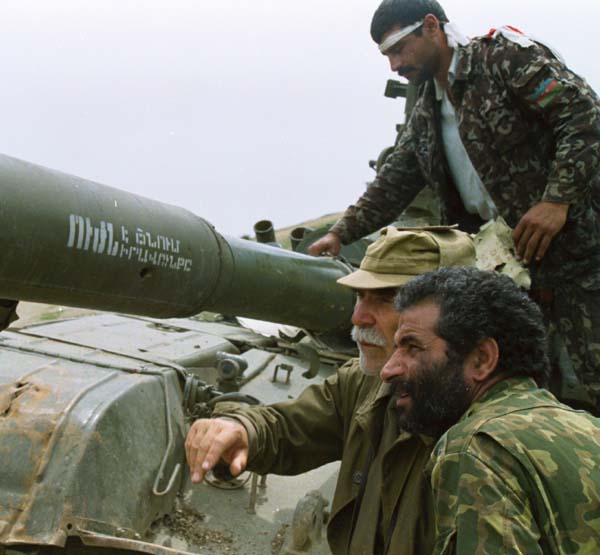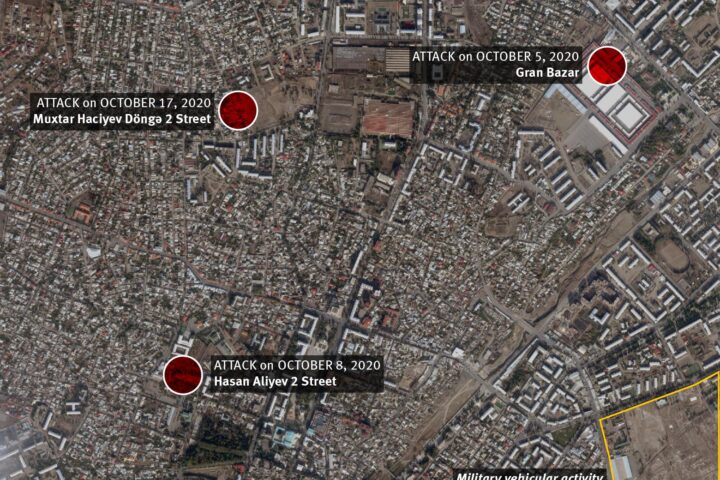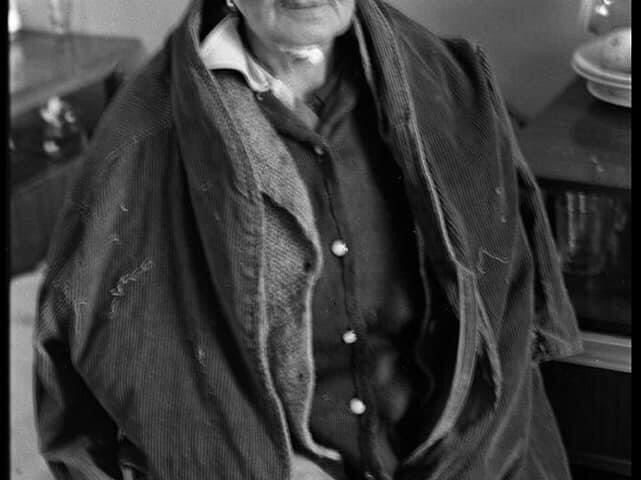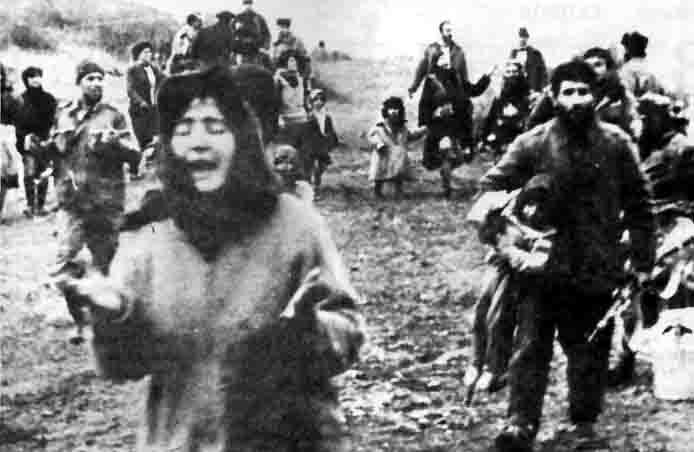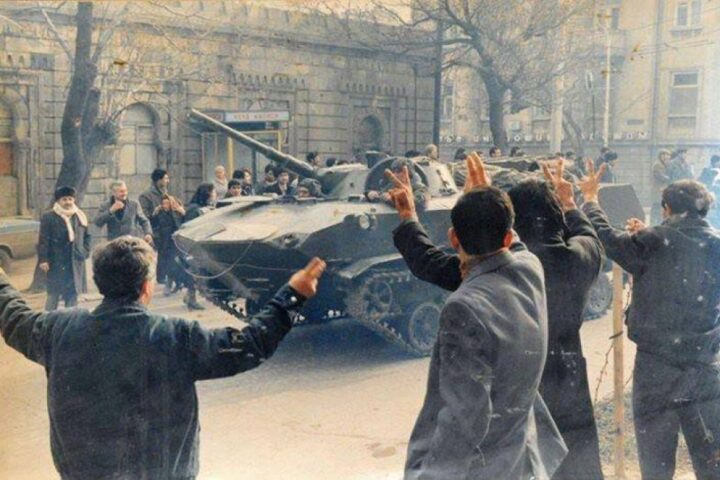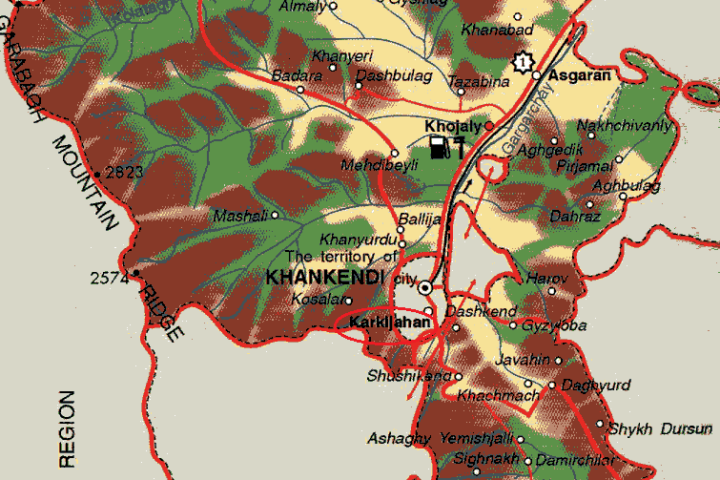1987
October – First meeting in Yerevan (Armenia) took place with challenges to annex the Nagorno-Karabakh Autonomous region (NKAR) of the Azerbaijan Soviet Socialist Republic to the Armenian Soviet Socialist Republic (SSR).
1988
February 22-23 – The first meetings in Baku and Sumgait took place with a slogan: «NKAR is the integral part of Azerbaijan».
February 24 – For the first time, in the course of the Armenian-Azerbaijani conflict blood was shed: in NKAR two Azerbaijanis were killed.
February 27 – Strikes started in NKAR with the demand to be separated from Azerbaijan.
February 28-29 – Pogroms and massive disorders in Sumgait took place. There were people, among the organisers of pogroms, of Armenian Nationality.
March 18 – Plenary Session of NKAR’s regional Committee adopted a decision on annexation of NKAR to Armenia.
March 24 – Central Committee of the Soviet Communist Party and Council of Ministers adopted a resolution «On measures for speeding up the social-economic development of NKAR of the Azerbaijan SSR in 1988-1995».
The first decade of May – More than one thousand Azerbaijani refugees, deported from Armenia, came to Azerbaijan.
May 18 – Meetings took place in Baku as a sign of protest against ejection of Azerbaijanis from Armenia.
The first decade of June – Discrimination acts against Azerbaijanis in NKAR broke out. In a few days about 2.000 people were ejected.
June 14 – According to State Committee on Statistics of Azerbaijan four more thousand refugees fled to the Republic.
The last decade of June – Ejection of Azerbaijanis from Armenia is going on.
July 12 – The Session of People’s Deputies of the Regional Soviet in NKAR adopted an anti-constitutional decision on separation from the Azerbaijani SSR.
July 13 – Presidium of the Supreme Soviet of the Azerbaijani SSR considered the decision of the session of the Regional Soviet from July 12, 1988, as an illicit act.
July 18 – The enlarged meeting of the Presidium of the USSR’s Supreme Soviet endorsed NKAR as belonging to the Azerbaijani SSR.
September 3-21 – Series of terrorist acts against Azerbaijanis in NKAR, setting out fire to houses and killing peaceful Azerbaijani population in Stepanakert.
November 18 – December 5 – Meetings took place in Baku with the demand to put an end to terrorist acts against Azerbaijanis in NKAR.
November 24 – The State of Emergency was announced in Baku, Nakhchivan, Ganja.
November 27-29 – As a result of anti-Azerbaijani massacres 33 Azerbaijanis were killed in the cities of Gugark, Spitak and Stepanavan of the Armenian SSR.
The second part of December – Exodus of Azerbaijanis from Armenia. More than 105 thousand refugees fled to Azerbaijan from the Armenian SSR.
1989
January 12 – In the territory of NKAR of Azerbaijan SSR a form of ruling was applied: Committee of special ruling was set up.
May-June – The First Congress of the People’s Deputies decided to form a Commission of the Supreme Soviet of the USSR on Nagorny Karabakh
July 7 – The Azerbaijani village of Karkijahan in NKAR was fired.
July 11 – The escalation of the situation in NKAR. An armed assault on Azerbaijanis in Stepanakert. People were killed.
July 29 – The traffic of trains from Azerbaijan to Armenia was cut short because of the attacks to the trains in the territory of Armenia. The beginning of the blockade of Nakhchivan Autonomous Republic of Azerbaijan by Armenia.
August 16 – There was the congress of the authoritative representatives of Armenian population of NKAR in Stepanakert, those refused to recognise the status of NKAR, as an autonomous region of Azerbaijan.
August 27 – The Presidium of the Supreme Soviet of the Azerbaijani Republic declared as illegal the decision of the congress of authoritative representatives of the Armenian population of NKAR from August 16, 1989.
The last decade of September – Strikes of the Azerbaijani railroaders in connection with the attacks to the trains in the territory of Armenia.
The second decade of October – The beginning of the blockade of Shusha region of NKAR, majority of the population of which is Azerbaijanis (91,7%).
The second decade of November – Assaults on Azerbaijani trains in the territory of the Armenian SSR, caused the stopping rail road traffic between the Azerbaijani SSR and the Armenian SSR.
November 28 – The Supreme Soviet of the USSR passed a resolution «on measures for normalising the situation in NKAR». It was decided to form the republican organisational committee on NKAR and to restore the activity of the regional council of the people’s deputies, by abolishing the Committee of special rule of NKAR.
December 1 – The Supreme Soviet of the Armenian SSR passed an anti-constitutional resolution «On reunification of the Armenian SSR and Nagorny Karabakh».
The first and second decades of December – Number of attacks from the territory of Armenia to the border villages of Azerbaijan were registered. The Infantry brigands from the territory of Armenia were landed in the regions of Khanlar and Shaumyan of Azerbaijan.
December 7 – The Presidium of the Supreme Soviet of the Azerbaijani SSR assessed this resolution of the Armenian Supreme Soviet from December 1, 1989 as inadmissible interference in the affairs of the Azerbaijani SSR, encroachment on its territorial integrity.
1990
January 9 – The session of the Armenian Supreme Soviet, considering the issues of planning and budget for 1990, included in its sphere of influence the plans of social-economic development of NKAR.
January 9 – Seizure of the Azerbaijani hostages by Armenians in the region of Shaumyan of Azerbaijan SSR.
January 4-10 – An illegal supply of about 100 tanks, artillery and anti-aircraft weapons by the Soviet Army to Armenia.
January 11 – The Azerbaijani Supreme Soviet condemned the decision of the Armenian Supreme Soviet to include NKAR in its economic sphere and assessed it as a grave violation of the sovereignty of the Azerbaijan Republic.
January 13 – As a result of the armed attacks Armenians occupied the village of Karki in Nakhchivan AR.
January 15 – An armed Armenian infantry were landed in the village of Gushchu of Khanlar region.
January 19 – Armenians assaulted on the settlement of Sadarak in Nakhchivan AR.
January 20 – The Soviet troops entered Baku, as a result 124 people were killed, 737 people were wounded. The State of emergency was declared in Baku and in other cities of Azerbaijan.
January 21 – The Supreme Soviet of the Azerbaijani SSR demanded the immediate withdrawal of the Soviet troops from Baku
February 13 – The Supreme Soviet of the Armenian SSR passed a resolution «On admission as illegal the decision of the Caucasian Bureau of the Central Committee of the Russian Communist Party of July 5, 1921», which left NKAR as part of the Azerbaijani SSR.
March 6 – The Presidium of the Supreme Soviet of the Azerbaijani SSR passed a resolution «On inadmissibility of territorial claims by the Armenian SSR».
March 7 – The Supreme Soviet of the USSR passed a resolution «On the situation in the Azerbaijani SSR and Armenian SSR and on the measures for normalising the situation in this region».
March 24 – The attack of the armed thugs of the Armenian SSR to the villages of the Gazakh region of the Azerbaijani SSR. All civilians of these villages were killed.
May 22 – The attempts to organise elections of the people’s deputies of the Armenian SSR in the territory of the NKAR failed.
May 25 – The resolution of the Supreme Soviet of the Azerbaijan SSR «On anti-constitutional decision of the Supreme Soviet of the Armenian SSR and its Presidium concerning NKAR of the Azerbaijani SSR».
June 25 – Decree of the President of the USSR «On prohibition to form armed forces which are not envisaged in the legislation of the USSR and confiscation of illegally kept weapons».
June 29 – The Council of Ministers of the Azerbaijani SSR passed a resolution «On resumption of sovereign rights of the Azerbaijani SSR in NKAR and measures for social economical development of the region».
September 23 – The People’s deputies of the USSR from Azerbaijan appealed the Supreme Soviet of the USSR «On forcible deportation of the Azerbaijani population of Armenia».
1991
January-May – The Armenian thugs committed terrorist acts against the leadership of the Committee of the special directorate of NKAR, the armed attacks and firing of the Azerbaijani villages.
May 9 – The USSR Ministry of the Internal Affairs, KGB and Ministry of Defence take measures for disarmament of the illegal Armenian armed forces and confiscation of weapons in the districts near the border of Azerbaijan and Armenia, as well as in NKAR of the Azerbaijani SSR.
June 29 – The Session of the Supreme Soviet of the Azerbaijani Republic draws the attention of the USSR President and the Supreme Soviet of the USSR to the new stage of escalation of Armenian thugs groups attacks in NKAR, as well as passes a decision to mom up the territory of NKAR from the thugs groups dispatched from Armenia and finish the measures of the USSR presidential decree banning the formation of armed forces.
September 2 – The Armenian separatists declared the establishment of so called «Nagorno-Karabakh Republic (NKR)» in the territory of Nagorny Karabakh region of the Azerbaijani Republic. All the armed groups of about 15.000 were formed as «self-defence forces of NKR» and subordinated to the Committee of Defence.
The middle of September – The Armenian armed forces began attacks the western part of Goranboy district of Azerbaijan and occupied number of inhabited settlements.
September 23 – Meeting of Presidents of Azerbaijan and Armenia in Zheleznovodsk (Russia) mediated by the Russian and Kazakhstan Presidents. There was reached an agreement on peaceful settlement of the conflict.
October-November – The Armenian armed forces launched hostilities to drive the Azerbaijani population out from the territories of Martuni and Hadrut districts of the NKAR. The USSR air forces took part in the hostilities supporting the Armenian forces. The Armenian forces occupied about 30 settlements.
November 20 – Near the village of Garakend of the Khojavand district of the Azerbaijan Republic the helicopter «MI-8» was shot down, in which there was the peacemaking group of the Russian, Kazakhstan representatives and the senior leadership of Azerbaijan. The murder of 22 people, including the state figures of the 3 countries put an end the first attempt for peaceful settlement of the Armenian-Azerbaijani conflict, undertaken in Zheleznovodsk and gave an impetus to the escalation of violence in the region.
The middle of December – The forces of the Ministry of Internal Affairs of the USSR were withdrawn from the territory of Nagorny Karabakh. Illegal transfer of weapons to Armenia by the Ministry of Internal Affairs of the USSR.
December 30 – The leaders of CIS countries called on Azerbaijan and Armenia to resume the negotiation process.
1992
January – The armed forces of Armenia relying on the support of rifle regiment 366 of the Russian armed forces, launched the occupation of the last Azerbaijani settlements of Karabakh which were in a complete isolation.
January 30-31 – The second meeting of the Council of CSCE (Prague). Azerbaijan and Armenia got the membership of CSCE. It was decided to send a mission of rapporteurs to the region of conflict.
The first half of February – Occupation of the suburb of Stepanakert (Karkijahan), as well as the Azerbaijani settlements along the road of Shusha-Khojaly and around Shusha.
February 12-18 – First visit of the CSCE mission of rapporteur to the region.
February 25-26 – Assault and seizure of the city of Khojaly (Nagorno-Karabakh region, Azerbaijan) by military forces of Armenia and with the participation of 366 Infantry regiment of the Russian military forces, as a result 800 civilians were brutally killed.
The end of February – Evacuation of the staff of the 366 Infantry regiment of the Russian military forces from Stepanakert and illegal transfer of 25 tanks, 87 armoured infantry fighting vehicles, 28 armoured vehicles, 45 artillery mortar systems to Armenians.
March 24 – Additional Helsinki meeting of the CSCE Council, decision to convene a conference on Nagorny Karabakh under the aegis of the CSCE. Chairman-in-Office designated Mr. Rafaelli as a Chairman of the Minsk Conference.
April – Beginning of the activity of Russia as mediator.
May 7 – Meeting of the Heads of Armenia and Azerbaijan in Tehran through the mediation of Iran (meeting was devoted to the normalisation of the situation in Nagorny Karabakh and to the peaceful settlement of the conflict).
May 8 – Military Forces of the Russian Army occupied azerbaijani city Shusha and Shusha region (Nagorny Karabakh) that led to the breakdown of agreements reached in Tehran. As the result of the occupation of Shusha region 23156 Azerbaijanis were driven out from their permanent residences. Thus, there was finished ethnic cleansing in Nagorny Karabakh.
May 18-19 – Military forces of the Republic of Armenia occupied Lachin region, which was outside Nagorny Karabakh. As the result of this occupation 63341 Azerbaijanis were banished from their homes. At the same time military forces of the Russian Army attacked strategically important part of the Azerbaijani-Turkish border in Sadarak region (Nakhchivan).
May 18-19 – In connection with the occupation of Lachin district of Azerbaijan decision making on an extraordinary preparing meeting of the CSCE participating states at the Conference on Nagorny Karabakh which was held under the aegis of CSCE was failed.
June-September – Rounds of negotiations were held within the framework of the CSCE Minsk group on the cessation of the offensive operations, de-escalation of the conflict and normalisation of the life of ordinary citizens.
September 19 – Agreements on cessation of all military actions in 2 months period reached by Defence Ministers of Armenia and Azerbaijan with the participation of the Ministers of defence and Security of Russia (Sochi).
September-November – Visits and consultations of the Russian mediator mission in the region.
November 26-December 1 – Meeting of the CSCE Ad-hoc group with the competence of advanced group of observes (Vienna).
December 7-9 – Unofficial meeting of the personal representatives of the Presidents of Azerbaijan, Armenia, Russia, USA and Turkey (Geneva).
December 9-12 – Violation of the agreement reached between Defence Ministers of Armenia and Azerbaijan in Sochi, Armenia occupied 8 villages of Zangelan district of Azerbaijan.
1993
February 5 – Beginning of the large-scale attacks of the military forces of the Russian Army in the northern part of the front.
March 17-21 – Meeting of Personal Representatives of Armenia, Azerbaijan, Russia, USA, Turkey and chairman of the CSCE Minsk group.
March 27-April 3 – Occupation of Kalbadjar district of Azerbaijan by the armed forces of Armenia, which is situated outside of Nagorny Karabakh, as a result of this 60698 Azerbaijanis were driven out from their permanent residences.
March 31 – Resumption of the meeting in Geneva. Personal Representative of the President of USA is breaking off the negotiations because of the occupation of Kalbadjar district of Azerbaijan by Armenia.
April 6 – The Statement of the Chairman of the UN Security Council, condemning the occupation of the district of Kalbadjar.
April 30 – The adoption of the resolution 822 by UN Security Council, demanding «the immediate withdrawal of all occupying forces from the district of Kalbadjar and other recently occupied districts of Azerbaijan».
June 3-4 – The Consultations of «the Minsk Nine». Adoption of «Schedule of urgent measures on implementation of the resolution 822 of the UN Security Council».
June 17 – The arrangement through the mediation of Russia on ceasing of bombardment of Aghdam and Stepanakert.
June 26-28 – The armed forces of the Republic of Armenia captured the city of Aghdara of the Republic of Azerbaijan.
June 27 – The arrangement through mediation of Russia on ceasing hostilities, shelling and air bombardment for one week in the districts of Mardakert and Aghdam.
July 12 – The visit of Mr. Rafaelli to Baku, Yerevan and Stepanakert aiming at adoption of the schedule of the Minsk Group.
July 18-20 – The visit of the mediator mission of Russia to Baku.
July 23-24 – The occupation of the district of Aghdam of Azerbaijan, which is situated outside of Nagorny Karabakh, by the armed forces of Armenia, as a result 158000 Azerbaijanis were driven out from their permanent residences.
July 29 – The adoption of the resolution 853 by the UN Security Council, demanding the immediate, complete and unconditional withdrawal of occupation forces involved in the conflict from the district of Aghdam and all other recently occupied districts of the Azerbaijan Republic.
July 21-August 12 – Consultations of OSCE Minsk Group. It was adopted «the schedule of urgent measures for implementing of the resolution 822 and 853 of the UN Security Council».
August 11 – Beginning of attacks of the Armenian armed forces to the district centers of Fizuli and Jabrail of Azerbaijan.
August 18 – The statement of the UN Security Council’s Chairman on immediate, complete and unconditional withdrawal of the occupation forces from the districts of Fizuli, as well as Kalbadjar and Aghdam and other recently occupied districts of the Azerbaijan Republic.
August 23 – The occupation of the district of Fizuli of Azerbaijan, situated outside of Nagorny Karabakh by the Armenian armed forces, as a result 152860 Azerbaijanis were driven out from their permanent residences.
August 25-26 – The Armenian armed forces occupied the district of Jabrail, situated outside of Nagorny Karabakh, as a result 57125 Azerbaijanis were driven out from their permanent residences.
August 31 – The Armenian armed forces occupied the district of Gubadly of Azerbaijan, situated outside of Nagorny Karabakh, as a result 31364 Azerbaijanis were driven out from their permanent residences.
September 21-28 – Negotiations within the OSCE Minsk Group were held in Paris.
October 14 – The UN SC passed a resolution 874, calling on the parties «to abstain from any hostile acts and any interference or invasion, which could led to escalation of the conflict and undermine peace and security in the region».
October 18-21 – Negotiations within the framework of the Minsk Group.
October 23 – Part of the military forces of the Armenian Republic assaulted the settlement of Horadiz with tanks. Having occupied this important transport unit, the Armenians cut off the district of Zangelan and part of none-occupied territory of Jabrail and Gubadly from the remaining part of the Republic.
October 28 – The military forces of the Armenian Republic occupied the rail road station of Minjivan.
October 28-November 1 – The occupation of the district of Zangelan, Azerbaijan, situated outside of Nagorny Karabakh, as a result, 34924 Azerbaijanis were driven out by the armed forces of Armenia from their permanent residences.
November 11 – The UN SC passed a resolution 884, demanding «immediate cease fire and hostility, unilateral withdrawal of occupation forces from the district of Zangelan and the city of Horadiz and withdrawal of occupation forces from other districts of Azerbaijan, captured recently».
November 20 – Firing of the mediator mission of Russia by the Armenian side. The statement of the former Russian Foreign Minister A.Kozirev on this matter.
December 10 -The Armenian military forces launched an assault in the direction of district center of Beylagan.
1994
January-March – Series of negotiations and consultations to reach an agreement on cease fire through the mediation of Russia and CSCE.
March 3 – Having broken off the next cease fire agreement, the Armenian troops resumed the hostilities.
March 31-April 3 – Visit of the peacemaker group of the Inter-parliamentary Assembly of CIS headed by Speaker of Kyrgizstan Supreme Council, together with Russian President’s representative, to Baku, Yerevan, and Nagorny Karabakh.
April 9-10 – The command of the Armenian Military Forces launched large scale assault in the direction of Terter during 33 days.
May 4-5 – The Bishkek meeting of the parliamentary leaders of Azerbaijan and Armenia and the representatives of the both communities from Nagorny Karabakh. The «Bishkek protocol» was adopted.
May 9 – The defence ministers of Azerbaijan, Armenia and the representatives of the Armenian separatist regime from Nagorny Karabakh signed a cease fire agreement.
May 12 – In the zone of conflict the regime of cease fire started functioning. Active hostilities on the line of the front came to an end.
May 19 – The CSCE Permanent Committee. It was passed a statement as a support for the agreement to strengthening of the cease fire regime.
June 27 – An agreement was signed by the parties as confirmation of their commitments on cease fire regime up to conclusion of the political agreement. The joint statement for to support this agreement was made by the leader of mediator mission of Russia and the chairman of the Minsk Conference.
August 28 – Unilateral statement of all sides involved in the conflict and confirmation of the commitments on observation of cease fire regime until the political agreement to be concluded.
September-November – Continuation of the negotiations between the competent representatives of the leaders of sides involved in the conflict in Moscow.
December 5-6 – Meeting of Heads of CSCE member states and governments in Budapest («Budapest Decision»). In accordance with the decision of the summit, it was established an institute of Co-Chairmen of the Minsk Conference; two stage structuring of the settlement process was completed; decision was taken on the OSCE peacekeeping operations after achievement of the political agreement.
1995
May-December – Series of negotiations within the framework of OSCE Minsk Group on elaboration of agreement for cession of the military conflict.
1996
January-November – Series of negotiations within the framework of OSCE Minsk Group on elaboration of agreement for cessation of the military conflict.
December 2-3 – Meeting of the Heads of OSCE States and governments in Lisbon. In the statement of the OSCE Chairman-in-Office three principles of the settlement of the Armenian-Azerbaijani conflict were formulated:
– territorial integrity of the Republic of Armenia and the Republic of Azerbaijan;
– legal status of Nagorny Karabakh defined in the agreement based on self-determination which confers on Nagorny Karabakh the highest degree of self rule within Azerbaijan;
– guaranteed security for Nagorny Karabakh and its whole population, including mutual commitments to ensure compliance by all parties with the provisions of the settlement.
These principles were supported by 53 OSCE participating states, except Armenia.
1997
February 13 – A. Tuleyev, the Minister on cooperation with CIS states made a statement on the facts of illegal supply of the Russian weapons to Armenia worth of 270 billion of rubles
February 14 – An institute of «triple» Co-Chairmanship of the OSCE Minsk Conference (Russia, USA and France) was established.
March 4-7 – The Azerbaijani parliamentary delegation headed by Arif Rahimzadeh, the first deputy chairman of the Azerbaijani Milli Majlis (Parliament) stayed in Moscow in order to find out the circumstances on the fact of supply of the Russian weapons to the Republic of Armenia.
March 14 – Appeal of the Azerbaijani Milli Majlis to B.Yeltsin, the President of Russia, E.Stroyev, the Chairman of the Council of Federation of the Federal Assembly of the Russian Federation, G.Seleznyev, the Chairman of the State Duma of the Federal Assembly of the Russian Federation.
April 2 – The report of Lev Rokhlin, the Chairman of the Defence Committee of the State Duma, on delivery of the Russian weapons to the Republic of Armenia worth of one billion US dollars.
April 4 – Appeal of the Azerbaijani Milli Majlis to B.Yeltsin, E.Stroyev and G.Seleznyev.
April 1-5 – The next round of the negotiations within the framework of OSCE Minsk Group was held, after it the Armenian side refused to hold further negotiations on the basis of proposals made by the Co-Chairmen, worked out according to the principles of the OSCE Lisbon Summit.
April 4-8 – The Azerbaijani parliamentary delegation headed by Arif Rahimzadeh, the first deputy Chairman of the Azerbaijani Milli Majlis (Parliament) stayed in Moscow in order to find out the circumstances on the facts of supply of the Russian weapons to the Republic of Armenia.
April 15 – The OSCE delegation headed by A.Kasprzyk, the Personal Representative of the Chairman-in-Office of OSCE, was fired by the Armenian side.
April 24 – The statement of the OSCE Chairman-in-Office in connection with the fire of A.Kasprzyk, the Personal Representative of the Chairman-in-Office in the zone of conflict.
June 23 – The Denver Statement of the Presidents of the US, Russia and France, supporting the search of ways for the settlement on the basis of the Lisbon principles.
September 1 – Illegal so-called «presidential elections» in Nagorny Karabakh, which was condemned by the world Community.
September 23-24 – Visit of the delegation of Co-Chairmen of the OSCE Minsk Group to Baku. Proposal on the stage-by-stage settlement.
October 10 – Strasbourg Joint Statement of the Presidents of Azerbaijan and Armenia on supporting plan of the stage-by-stage settlement of the conflict.
December 17-19 – The Meeting of the OSCE Ministers of Foreign Affairs in Copenhagen. The Chairman-in-Office requested the Co-Chairmen of Minsk Group «to continue their work and urged all sides to resume the negotiations without delay on the basis of the proposal of the Co-Chairmen».
1998
April – The refusal of Armenia from the early reached agreements on the stage-by-stage settlement of the conflict.
May 13-17 – Visit of the Co-Chairmen to the region. Armenia officially declared about the renunciation of the consent of the former President of the Republic of Armenia with the proposal on the stage-by-stage settlement and supported the package settlement without any preliminary conditions.
July 14-15 – Visit of I.Sergeyev, the Russian Defence Minister, to Armenia, in the course of which an agreement on supply of anti-aircraft weapons S-300 was reached.
November 8-10 – The OSCE Minsk Group Co-Chairmen offered a new plan of settlement of the conflict, based on the principle of «common state». The Azerbaijani side refused to accept this proposal as a basis of resumption of negotiations. Azerbaijan confirmed its readiness to resume negotiations within the framework of the OSCE Minsk Group on the basis of the proposals of the Co-Chairmen of September 19, 1997, on the stage-by-stage settlement of the conflict.
December 2-3 – The meeting of the OSCE Ministers of Foreign Affairs in Oslo, where the Chairman-in-Office called upon the sides involved in the conflict to resume the negotiations within the framework of the Minsk Group without delay.
December 16 – Deliver of 5 Russian MiG-29 fighter aircrafts to Armenia.
1999
February 26 – Additional deliver of 5 MiG-29 fighter aircrafts and surface-to-air missile systems S-300 to Armenia.
March 11 – It was adopted the resolution on «Support of peace process in Caucasus» on the plenary meeting of the European Parliament for supporting of the peace plan offered by Minsk Group and continuation of the efforts for long-termed settlement of the conflict.
March 19 – Milli Majlis (Parliament) of the Republic of Azerbaijan appealed to the European Parliament, criticizing some provisions of the resolution on «Support of peace process in Caucasus».
April, 2 – Meeting between the presidents of Azerbaijan and Armenia H. Aliyev and R. Kocharian was held in Moscow. The arrangement about intensification of contacts and opinion exchange for seeking of ways for conflict settlement was reached between the presidents.
April, 24 – Meeting between the presidents of Azerbaijan and Armenia H. Aliyev and R. Kocharian was held in Washington through mediation M. Albright. There was put proposals for development of regional cooperation and measures for strengthening of confidence. As a result, Washington declaration was adopted.
May – Delivery 8 rockets «Tayfun» with range 60-80 km by China to Armenia
May, 25 – Hearings on Armenian-Azerbaijani conflict settlement at the meeting of EC PA Commission on political issues. Speaker of Azerbaijan parliament M. Aleskerov and leader of Azerbaijani population of Nagorniy Karabakh N. Bakhmanov addressed the meeting, stating position of Azerbaijan.
June, 3 – Statement of Foreign Ministry of the Azerbaijan Republic in connection with delivery of «Tayfun» rockets by China to Armenia
June, 14 – Units of armed forces of Armenia violated cease-fire regime and attacked positions of Azerbaijani troops along the Contact line in Negorno-Karabakh region. In connection with this incident UN Secretary-General, OSCE Chairman-in-Office, US State Department and Foreign Ministry of Russian Federation issued statements.
June, 18 – Additional delivery of 4 fighters MiG-29 by Russia to Armenia. Foreign Ministry of Georgia made a protest in connection with violation of airspace of the country by these fighters.
June, 28 – July, 1 – There was adopted two statements at the XXVI conference of foreign ministries of OIC member-states:
1. About aggression of Republic of Armenia against Republic of Azerbaijan
2. About demolition and destruction of Islamic historic and cultural monuments in the occupied territories of the Azerbaijan Republic as a result of aggression of the Republic of Armenia against the Republic of Azerbaijan
July, 16 – Meeting of the presidents of Azerbaijan and Armenia in Geneva. Opinion exchange on conflict settlement.
August, 22 – Meeting between the presidents of Azerbaijan and Armenia in Geneva. Consultations for seeking of ways for the conflict settlement were contiued. As a result of negotiations, instructions on providing the measures for strengthening of cease-fire regime and resumption of negotiations within the frames of OSCE Minsk Group was given to foreign and defense ministries of two countries.
September, 1-2 – Visit of OSCE Minsk Group co-chairmen representing USA and Russian Federation K. Kavanaugh and N. Gribkov to Baku with the aim to study the situation in the region.
September, 10 – During the international conference «Baltic-Black Sea Cooperation: Towards an Integrated 21st Century Europe Without Dividing Lines» in Yalta, meeting between the presidents of Azerbaijan and Armenia was held, and opinion exchange on issues of strengthening of existing cease-fire regime and seeking of the ways of peace settlement conflict was continued. The parties agreed to resume negotiation process within the framework of OSCE Minsk Group.




